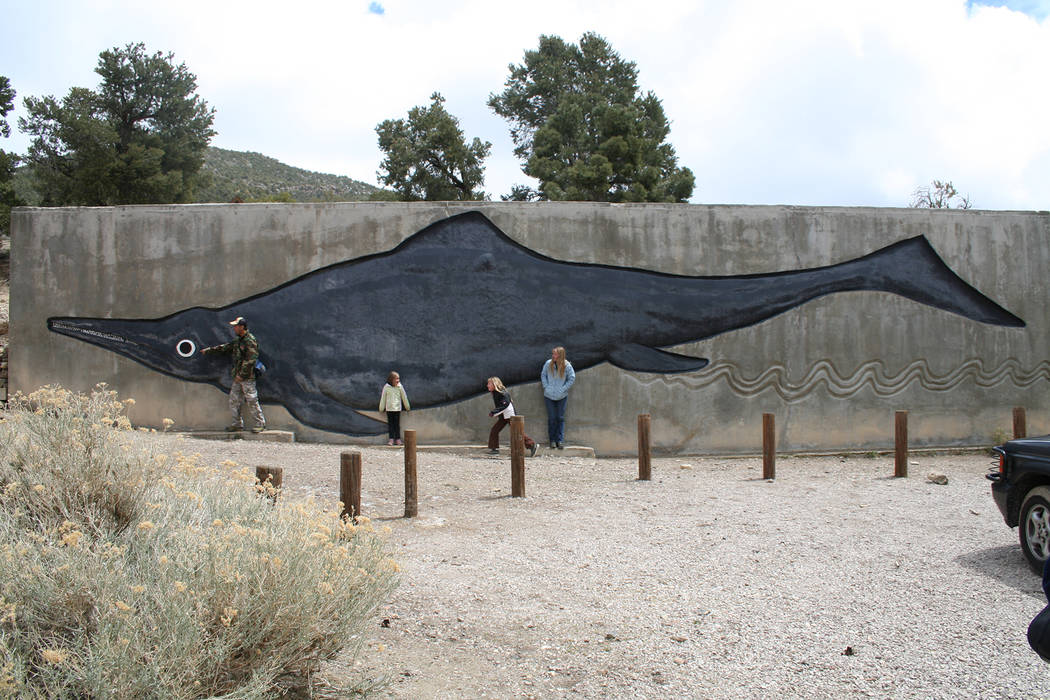
It takes some time to drive to Berlin-Ichthyosaur State Park, located a couple hours north of Tonopah, but the road trip is worth it, especially in summer, when the temperatures are at their most pleasant — perfect for seeing the historic sites, picnicking and camping. On the western edge of the Shoshone Mountains, the 1,540-acre park has elevations ranging from 6,840 to 7,880 feet.
Nevada has 23 state parks, mostly set aside for one unique feature, but this park has several. It boasts a well-preserved historic mining town and the remains of the ancient ichthyosaur (pronounced ick-thee-o-saur), our state fossil.
When you enter the park, the first place you will come to is the Berlin Townsite Area. Prospectors back in 1863 discovered the Union Ledge, the initial big ore find in the area. When other valuable discoveries were made in the general area, this became the Union Mining District, and Berlin was added to it in 1896. The place didn’t last very long because of low yields and labor disputes; it pretty much became a ghost town by 1911.
Nevada’s abandoned mining towns were themselves mined for building materials and even entire buildings, moved to places they could be more immediately useful. Thankfully, because it was off the beaten track, Berlin remained in very good shape compared to most ghost towns. The best way to enjoy it is to set out on foot and hike the paths to the more than 70 historic sites, most marked by interpretive plaques. Be sure to see the Berlin Mill, the largest structure in the townsite. Here you will find remains of a bank of stamps — the simple but huge and heavy devices used to pulverize ore for processing — separating tables and other historic relics. You won’t see them, but at one time this building housed 30 stamps, a crusher, steam engines and boilers.
Once you tour this townsite, drive up the gravel road about 1.7 miles. There you will arrive at the signed covered quarry site, on your right, home to the ichthyosaur fossils. The fossils here were discovered by a Stanford University professor in 1928. While they knew about them, the place wasn’t excavated until 1954.
The ichthyosaur were marine reptiles, which swam the ocean that was located here more than 200 million years ago. They are thought to have descended from reptiles that formerly lived on land — an evolutionary path surprisingly similar to the one believed to have produced today’s whales and dolphins. Like whales and dolphins, ichthyosaurs probably breathed air and bore live young.
At this site, you will find the remains of nine different ichthyosaurs. You will see skulls, jawbones, backbones, flipper and tail bones and a ribcage. Ichthyosaurs have been found on every continent except for Antarctica, but the ones here are some of the largest, reaching 50 feet long.
Tours run in summer through Labor Day at 10 a.m. and 2 p.m. On Saturdays and Sundays there is an additional tour at noon. If you can’t make one of the tours, there are viewing windows, but using the windows doesn’t offer the thrill of being up close to these ancient ones.
The closest lodging is hours away, so camping is usually the way to go. There is a fine campground with 14 sites that are good for car, tent or RV (up to 25 feet in length) camping. The sites have fire pits, barbecues and covered picnic tables. Water is available in season, usually through October. Always call ahead for fire restrictions. Camping fees are $17 per night. Entrance fees to the park are $7 per vehicle.
For more information, contact the park at 775-964-2440 or visit http://parks.nv.gov/parks/bi.
Many of Deborah Wall’s columns have been compiled in the book “Base Camp Las Vegas, Hiking the Southwestern States.” She is also the author of “Great Hikes, a Cerca Country Guide” and a co-author of the book “Access For All, Seeing the Southwest With Limited Mobility.” Wall can be reached at Deborabus@aol.com.
Directions
From Boulder City, take U.S. Highway 95 north for 312 miles, passing through Tonopah. Go right onto Nevada Route 361 and follow for 28 miles to Gabbs. Take a right onto Nevada Route 844 and drive 16 miles to park.